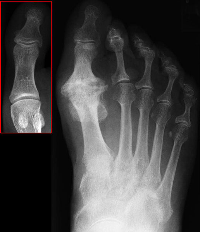Hallux Rigidus
The term hallux rigidus is a Latin term that literally means "stiff big toe." It refers to a painful arthritic condition of the big toe characterized by stiffness and bone spur formation about the big toe joint.
Other than bunions, hallux rigidus is the most common condition to affect the great toe. This condition may severely impair a person's ability to walk or run.
The cause is not truly known but it may be associated with prior injury, heredity, abnormal posture of the foot and abnormalities of bone and muscle structure.
X-rays
- X-rays show bone spurs and sometimes a decrease in the cartilage space or joint.
- X-rays also help your doctor appreciate what might be the cause of your condition.
- These x-rays demonstrate bone spur formation especially on the lateral view.
- This person's MTP joint is well preserved.
- Despite this the toe is stiff and painful.
Non-Surgical Treatment
- Non-operative treatment involves shoe-wear modification to allow for the bump on the top of the shoe. One can also wear stiffer shoes to protect the joint. Maintaining range of motion, when the joint begins to stiffen is also important.
- Medications such as ibuprofen are sometimes helpful to decrease swelling and improve comfort.
Surgical Treatment
- Operative treatment is considered when conservative measures fail and entails different procedures depending on the activities of the patient, the severity of joint involvement and the cause of the hallux rigidus. In general, milder disease requires a joint clean out. More severe disease requires a fusion.
- Procedures vary from cleaning out the joint and bone spurs at one end of the spectrum to fusing the joint using plates and screws at the other end.
- Recovery from surgery averages 1 month after a joint clean, with motion exercises and progressive weight bearing in a bunion shoe.
- A joint fusion requires 3 months of recovery. The patient wears a post op shoe for 3 months. The first six weeks, the patient is allowed to walk on the heel. Normal walking is allowed the second six weeks if X-rays reveal a healed fusion sit. After 3 months, the patient returns to a regular shoe and regular activities.
Recovery Time
The time required to be off from work will depend upon the type of work being performed and the type of shoe that must be worn. If the patient can work with their foot propped up and elevated with limited walking they may be able to return to work within a week of surgery. Patients who have jobs that require prolonged standing, walking, kneeling, or climbing may be off from work for as long as four to six weeks.
It is normal to have swelling and mild pain for up to 6-8 months after surgery.

